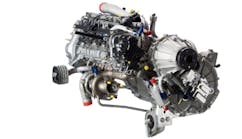GE Aerospace Celebrates Ribbon Cutting of Services Technology Acceleration Center
GE Aerospace celebrated the ribbon cutting of its Services Technology Acceleration Center (STAC), a state-of-the-art facility dedicated to advancing aerospace inspection technologies and repair processes and enhancing customer support capabilities for its Maintenance Repair and Overhaul (MRO) facilities around the globe.
The STAC is a hub for rapidly industrializing and deploying cutting-edge technologies and methodologies for inspecting jet engine parts to drive greater rigor around safety and improve turnaround times on inspection. The center will house state-of-the-art inspection technologies, powered by AI and machine learning, that will be able to detect emerging issues sooner and help get customers’ engines back on wing faster.
STAC, which opened earlier this fall, is in the process of finalizing certification of several technologies, which will be deployed across the company’s Maintenance, Repair and Overhaul facilities globally.
“The Services Technology Acceleration Center provides us with an unprecedented capability to rapidly industrialize and scale the most advanced inspection solutions using AI, automation, and robotics, to our global network of MRO organizations,” said Russell Stokes, President and CEO, Commercial Engines and Services. “With each new deployment from the STAC, we will give our MRO organizations better tools to meet the ramp in services demand and reduce turnaround times for engine overhauls.’
Along with improving the quality and detail of part inspections, these new inspection processes will improve the cost of ownership on jet engines for airline customers by more clearly delineating airworthy repaired parts that can be returned to the field in lieu of replacing them entirely with new parts.
In addition to advancing state-of-the-art inspection capabilities, STAC houses more than 20 special repair processes and 50 manufacturing engineers focused on substantiating the use of next generation repair technologies. GE Aerospace’s investment in developing and deploying these step-change repair processes will help further reduce cost of ownership for customers and turnaround time for maintenance events.
GE Aerospace is in the process of moving its first two advanced inspection technologies, XRF, and white light inspection, into the STAC. Once in STAC, these new solutions will be industrialized and prepared to deploy to parts of GE Aerospace’s MRO network. Additional technologies that will be industrialized at the site include ultrasound, computed tomography, flash thermography, eddy current testing, fluorescent penetrant inspection, and dimensional metrology.




